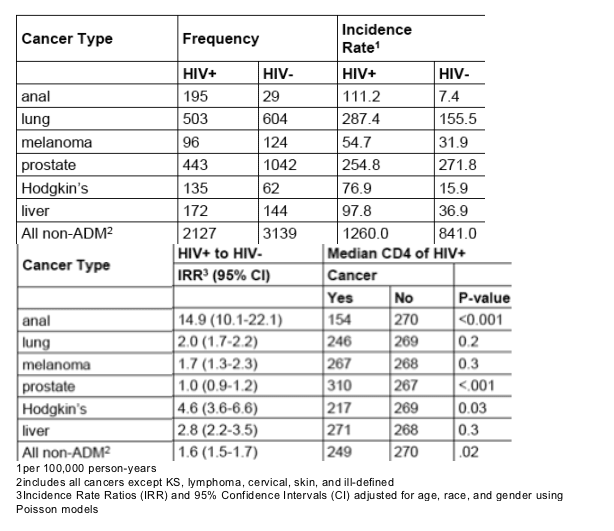 |
 |
 |
| |
Cancer Rates Higher in HIV+, CD4s Lower
|
| |
| |
Incidence of Non-AIDS-Defining Malignancies in HIV-Infected Vs. Non-Infected Veterans in The HAART Era: Impact of Immunosuppression
Reported by Jules Levin
ICAAC Sept 17-20, 2007, Chicago
R. J. BEDIMO1,2, M. DUNLAP 2, K. A. MCGINNIS 3, M. RODRIGUEZ-BARRADAS 4, A. C. JUSTICE 5;
1VA North Texas Hlth.Care System, Dallas, TX, 2UT Southwestern Med. Ctr., Dallas, TX, 3VA Pittsburgh Healthcare Ctr.,
Pittsburgh, PA, 4Michael E. DeBakey VA Med. Ctr., Houston, TX, 5Yale Univ. Sch. of Med., West Haven, CT.
In the Highly Active Antiretroviral Therapy (HAART) era, there has been a significant decline in the incidence of AIDS-defining malignancies (ADM). Conversely, several reports indicate that the incidence of most non-AIDS-defining malignancies (non-ADM) is either unchanged or increased. Because of the lack of suitable comparison group, it has however remained unclear whether non-ADM incidence remains significantly higher in HIV infected (HIV+) than in age-, race-, and gender-matched non-HIV subjects (HIV-).
METHODS
We used the Veterans Administration electronic medical records system to identify HIV+ and age, race, and gender matched HIV- veterans receiving care during fiscal years 1997 through 2004 (HAART era). ICD-9 codes were used to identify veterans diagnosed with malignancies during the observation period.
Veterans with cancer prior to the observation period were excluded from
analyses for that particular cancer.
Incidence rates of malignancies were calculated and compared between HIV+
and HIV- veterans.
To determine the association of immunosuppression on the rates of malignancies in HIV+ veterans, median CD4 counts closest to first observation date were compared.
RESULTS
A total of 33,420 HIV+ and 66,840 HIV- veterans were followed for a median of 5.1 and 6.4 years respectively.
Incidence rates of non-ADM per 100,000 person-years were 1260 and 841 among HIV+ and HIV- patients respectively.
Compared to HIV-, the incidence rate ratio (IRR) of non-ADM in HIV+ was 1.6 (95% CI: 1.5-1.7).
IRRs were highest for anal (14.9; CI: 10.1-22.1), Hodgkinis (4.6; CI: 3.6-6.6), liver (2.8; CI: 2.2-3.5), and lung (2.0; CI: 1.7-2.2) cancers.
Compared to HIV+ patients without cancer the median CD4 counts were lower for of all non-ADM patients (249 vs. 270, p=0.02), anal cancer (154 vs. 270; p<0.001), and Hodgkinis (217 vs. 270; p=0.03), except prostate cancer, which was associated with a higher CD4 count (310 vs. 270; p<0.001).

CONCLUSIONS
In the HAART era, the incidence of non-ADMs is significantly higher among HIV+ than HIV- veterans, adjusting for age, race, and gender.
Some non-ADMs appear to be associated with mild immunosuppression.
Potential explanations for the increases in non-ADM rates include:
--Longer survival of HIV patients on HAART, but only partial immune recovery is
achieved in majority of patients.
--High incidence of active EBV and HPV replication in HIV-infected patients.
--Potential oncogenicity of long-term HIV infection, or of long-term HAART therapy
|
| |
|
 |
 |
|
|